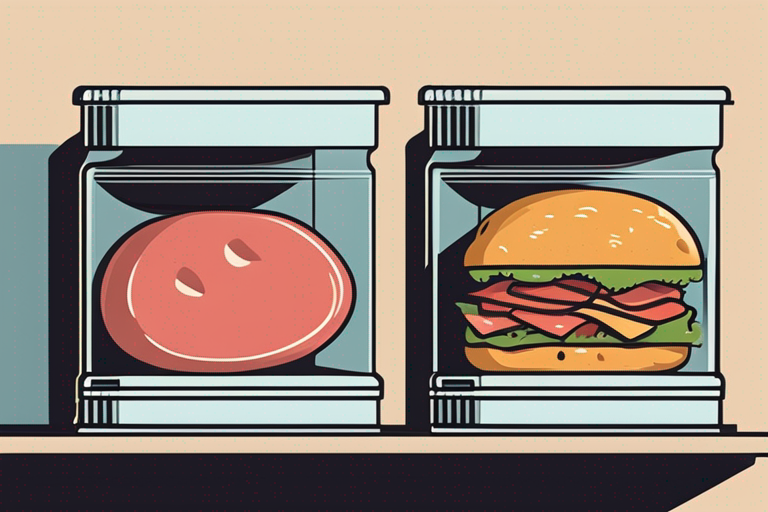
The Dangers of Eating Expired Packaged Food
Get Your Free Food Safety Cheat Sheet
30 most common foods with instant answers. Print it and stick it on your fridge—completely free!
The Dangers of Eating Expired Packaged Food
In today's fast-paced world, it's easy to overlook the expiration dates on packaged food items. We've all been guilty of reaching for that can of soup or box of crackers past its prime. But what many people don't realize is that consuming expired packaged food can pose serious health risks. In this comprehensive guide, we'll explore what happens when you eat expired packaged food and provide practical tips for ensuring food safety.
Understanding Expiration Dates on Packaged Food
Packaged food items typically come with expiration dates printed on the packaging. These dates can include "best by," "use by," and "sell by" labels. While these dates are meant to indicate when the food is at its peak quality, they are not always a strict indicator of food safety.
Types of Expiration Dates:
- "Best By" Date: This date indicates when the food may start to lose its optimal quality.
- "Use By" Date: This date is a recommendation for when the food should be consumed for the best taste and quality.
- "Sell By" Date: This date is more for the retailers and indicates how long the store should display the product for sale.
Risks of Consuming Expired Packaged Food
Eating expired packaged food can lead to various health hazards due to the potential growth of bacteria, molds, and other harmful pathogens. Here are some risks associated with consuming expired food items:
Food Spoilage:
- Bacterial Growth: Expired food is more likely to harbor harmful bacteria like Salmonella, E. coli, and Listeria, which can cause food poisoning.
- Mold Growth: Mold can develop on expired food items, producing mycotoxins that can lead to allergic reactions or even toxicity.
Nutrient Degradation:
- Vitamin Loss: Over time, essential vitamins and minerals in food can degrade, reducing the nutritional value of the expired food.
Allergic Reactions:
- Cross-contamination: Expired food may come into contact with allergens, leading to allergic reactions in sensitive individuals.
Digestive Issues:
- Upset Stomach: Consuming expired food can result in digestive issues like diarrhea, nausea, and abdominal pain.
Tips for Ensuring Food Safety
To reduce the risks associated with eating expired packaged food and maintain food safety, consider the following tips:
Storage Practices:
- Follow Storage Instructions: Store food items according to the manufacturer's recommendations, such as keeping perishables in the refrigerator.
- Rotate Stock: Practice "first in, first out" to ensure older items are used before newer ones.
Inspection and Discard:
- Check Expiration Dates: Regularly inspect food items for expiration dates and discard any expired products.
- Inspect for Signs of Spoilage: Look for changes in color, texture, and odor, which may indicate spoilage.
Proper Handling:
- Avoid Cross-contamination: Keep raw and cooked foods separate to prevent the spread of bacteria.
- Wash Hands: Always wash your hands before handling food to reduce the risk of contamination.
Cooking Practices:
- Cook Thoroughly: Ensure that food is cooked to the recommended internal temperature to kill any bacteria present.
- Refrigerate Promptly: Refrigerate leftovers promptly to prevent bacterial growth.
Conclusion
While it may be tempting to overlook expiration dates on packaged food items, the risks of consuming expired food are not worth the gamble. By understanding the dangers associated with eating expired food and following proper food safety practices, you can protect yourself and your loved ones from potential health hazards. Remember, when in doubt, it's always best to err on the side of caution and prioritize food safety above convenience. Stay informed, stay safe, and enjoy your meals with peace of mind.

Authoritative Food Safety References
These agencies and university labs inform every tip and health precaution we publish.
USDA FoodKeeper – Cold Storage Guidelines
Official refrigerator, freezer, and pantry timelines maintained by the U.S. Department of Agriculture.
Visit USDA FoodKeeperFDA Produce Safety Rule & Grower Guidance
Field-to-fridge handling practices that prevent contamination of fruits, vegetables, and leafy greens.
Visit FDA Produce SafetyCDC Foodborne Illness Prevention Hub
Surveillance-backed guidance on pathogens, symptoms, and steps to reduce foodborne illness risk.
Visit CDC Food SafetyUC Davis Postharvest Technology Center
University research detailing optimal storage atmospheres for produce after harvest.
Visit UC Davis PostharvestPenn State Extension – Home Food Preservation & Safety
Peer-reviewed extension bulletins on safe canning, chilling, and reheating practices.
Visit Penn State ExtensionHow can you tell if packaged food has gone bad?
What are the dangers of eating expired packaged food?
How should expired packaged food be disposed of?
Can expired packaged food be safely consumed after cooking?
Get Your Free Food Safety Cheat Sheet
30 most common foods with instant answers. Print it and stick it on your fridge—completely free! Want more? Upgrade to the complete guide with 70+ foods.
Scan your food directly and get instant safety info using our AI-powered camera feature.